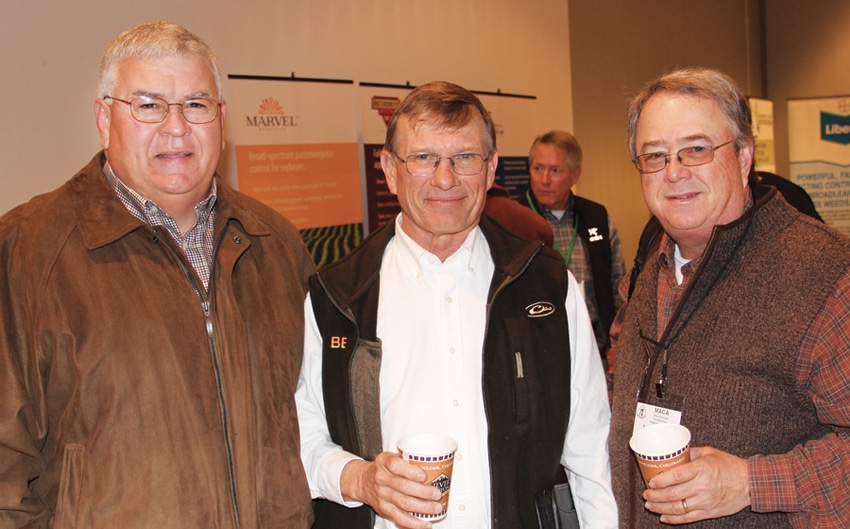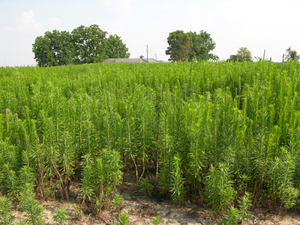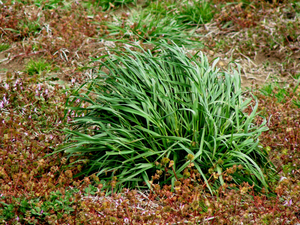
Making a herbicide application after the planter has already gone through the field often involves “a very narrow window of opportunity, especially when temperatures are warm,” says Tom Eubank, assistant Extension and research professor at the Delta Research and Extension Center, Stoneville, Miss. “The approach I advocate is for the planter to chase the sprayer, and where farmers used this approach last year, they didn’t have nearly the injury issues we saw when we were making an application behind the planter."

To reduce the amount of herbicide injury in soybean, says Tom Eubank, growers should “stop chasing the planter with the spray rig, and instead chase the spray rig with the planter.”
While soybean growers have a roster of effective residual herbicides for use against Palmer amaranth (pigweed), he says, they should be aware that crop injury can occur.
“We’ve got to have residual herbicides to manage our weeds,” he said at the annual meeting of the Mississippi Agricultural Consultants Association, “and we may have to accept some level of crop injury as a necessity in order to get the benefits that come from using these products. But we can significantly reduce this injury potential by changing the timing of these applications.”

TOM EUBANK
Eubank, assistant Extension and research professor at the Delta Research and Extension Center, Stoneville, Miss., said the 2013 crop year is a good example of the injury scenario.
“We had an almost perfect storm: We’d get a rainfall event, then run out into the field to plant and spray; then we’d get a rain, and we’d repeat the process. As a result, we had a lot of fields with a lot of injury from several different herbicides.”
RELATED: Diversity helps soybean growers manage weeds and herbicide resistance
Making a herbicide application after the planter has already gone through the field often involves “a very narrow window of opportunity, especially when temperatures are warm,” Eubank says.
“You might only have two or three days before soybeans start cracking the soil surface, and if there are weather delays, you may not be able to apply these residual herbicides prior to soybean emergence. Then, you’re forced to use postemergence materials earlier in the season than is really warranted — or worse, you may not be able to get them out at all.
“The approach I advocate is for the planter to chase the sprayer, and where farmers used this approach last year, they didn’t have nearly the injury issues we saw when we were making an application behind the planter.
“I would prefer to apply these herbicides seven to 10 days prior to planting, when we have a combination of things working for us. One, we’ve got much less injury potential — if the herbicide gets incorporated before the beans come up, we’re less likely to see injury occur. Two, our window of application is much wider.
Let planter chase spray rig
“A lot of farmers have called me and said weather kept them from making these applications. The best way to avoid this scenario is to make the application prior to planting. Even if you do it four or five days before planting, that’s better than making an application after the planter, in my opinion. Your spray rig can go a lot faster than your planter can go.”
Another point to consider, Eubank says, is that if these residual herbicides are applied earlier, then their length of residual will be shortened in-season. “This will necessitate that the first over-the-top herbicide treatment be moved up as well, and also that an additional residual herbicide should be included. Again the benefits are many in that applications of residual herbicides applied over-the-top are much less injurious on smaller soybeans. “Additionally, there is a greater chance these residual herbicides will contact soil, were they are most effective ,as opposed to being intercepted by the crop, and in many cases rendered ineffective.”
Two problem weeds, horseweed and Italian ryegrass, require that an effective herbicide program be used, Eubank says.

HORSEWEED (Mississippi Extension Service photo)
“For horseweed, we’ve been using glyphosate and 2,4-D or dicamba combinations, and these programs have been fairly successful. But we’re starting to see increased tolerance to these combinations.
“Dicamba rates have increased incrementally over the years. In Mississippi, we’re now using about 8 oz. of dicamba, but in Tennessee, Arkansas, and Alabama, they’ve had to increase rates to 10 oz. to 12 oz. to get an effective level of control of horseweed.
“Even though we’ve not yet documented dicamba resistance in horseweed, it’s highly suspect that we may be coming to that point in the near future.”
Farmers using combinations of dicamba, 2,4-D, and glyphosate, are getting somewhat better control, Eubank says.
“I like the combination of glyphosate, Sharpen, and 2,4-D on horseweed. If you can catch the weeds early, adding Sharpen really beefs up the 2,4-D and you can control somewhat larger horseweed with this combination.”
Closer to planting, he says, “I’d recommend a paraquat plus metribuzin combination, which works well. With this combination, you get a synergistic effect and better control. An added advantage is control of emerging pigweed.”
With paraquat, Eubank says, “Coverage is essential — you need a good water volume and fine droplets to get the spray down into the growing point.”
Burndown window is expanding
The burndown window for many growers, he says, “has now become from January to planting season. In some cases, we’re applying two burndown treatments — one early season to control winter weeds, and a second prior to planting to control pigweeds and other emerging weeds.
“We’re using a lot of paraquat/metribuzin combinations in soybeans that not only clean up some of the escapes that may have got by the glyphosate/2,4-D early on, but also control pigweeds that may be popping up.”
Liberty is a good option on horseweed, particularly near planting, Eubank says. “We have research that shows if you don’t control horseweed prior to planting corn, cotton, or soybean, it can adversely affect yield. In every scenario where we applied Liberty at planting, we got a yield increase.
“Liberty is expensive, but if you get into a salvage situation where you need to control horseweed, it does a good job. You can combine it with metribuzin for synergy, but again it’s important to have adequate water volume and coverage for the Liberty to work properly. And you also need warmer temperatures and sunlight.
“Research has shown that from about 10 a.m. until about dusk is the best time to apply Liberty. Standard advice has been that the best time to spray is early morning in order to get good coverage and limit drift. But, Liberty efficacy goes down the earlier in the morning you apply it — as much as 20 percent to 30 percent reduction in control. Heat and photosynthetic activity are important with this product.”
A glyphosate plus FirstRate combination is another good option for horseweed, Eubank says. “Typically, I’d rather see this go out in-crop, when horseweeds and soybeans are already up. This doesn’t really kill the horseweed — it basically shuts down the growing point, and the plant just sits there for a long period of time, allowing the beans to canopy and shade out the weed.”
Although some growers have used Resource, he says it is not effective on horseweed, nor is paraquat alone. And not all of the ALS-inhibitor herbicides are effective. While FirstRate and Envoke have good activity, he says, for Leadoff, First Shot, Harmony, “horseweed has to be really, really small for them to work effectively.”
Cover crops a weed control option
For Italian ryegrass, which has documented herbicide resistance, Eubank says, “The best approach we’ve found is with fall residuals. If you really attack ryegrass with fall residual applications and a timely spring application, you can get rid of it in two years. But many growers say that because of erosion and other problems, they need to work their fields and need a different program.

ITALIAN RYEGRASS (Mississippi Extension Service photo)
“In such cases, a good option is a cover crop. I know for many Mid-South growers, this isn’t a very popular subject, because it means more inputs and it requires management during the winter.
“You’ve got to buy seed, and get it planted, and you also need to manage weeds in the cover crop. On the other hand, if you’re putting out a residual in the fall, then a burndown, and then something else at planting — that’s three herbicide applications. So, a cover crop may be a good alternative.
“Herbicide-resistant and hard-to-control weeds are a serious enough issue that I think a cover crop is going to be an essential part of farm management programs — not just for the benefit of reducing sediment loss, but also to help manage weeds.”
In his research program, Eubank says, “We’ve got fields rowed up on 30-inch beds and planted with a wheat cover crop. I could burn them off tomorrow and plant and those beds would still be in nice shape.”
Henbit continues to cause problems for many growers, he says. “Glyphosate and 2,4-D has been our standard treatment for a long time, but now it probably isn’t the preferred choice. Glyphosate/dicamba has also not been very effective the past few years.
“Henbit can be an expensive problem given the right situation. Your best bet is probably with an ALS inhibitor; something like Canopy EX, LeadOff, or Harmony will do a good job.”
Ag news delivered daily to your inbox: Subscribe to Delta Farm Press Daily.
About the Author(s)
You May Also Like



